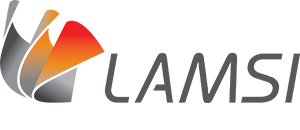Areas of Research
Since the acquisition of a new additive manufacturing infrastructure in 2015, LAMSI has been focused on gaining a better understanding of the relationship between the design, process, microstructure and properties of components produced using additive manufacturing (AM) technologies.
A more profound understanding of this fundamental relationship makes it possible to take advantage of the design freedom and transformative potential provided by AM technologies.
The five phases of the additive manufacturing process:
Design and Prototyping
- High-performance structural components.
- Medical implants and tools.
- Damage-Tolerant Design and Quality Control: Our work involves predicting the fatigue resistance of AM components in order to further support the integration of AM technologies into aerospace and medicine.
Step 1: Specimens with controlled levels of porosity are manufactured and inspected using X‑ray computed tomography.
Step 2: Crack propagation and stress-controlled fatigue testing is conducted in order to construct Paris and Wohler diagrams.
Step 3: Both diagrams are combined to build a model that correlates the fatigue life of laser powder bed fusion (LPBF) components with the level of processing-induced flaws.
This combined approach allows for the establishment of industrial procedures for damage-tolerant design and quality control of LPBF components for critical applications.
New AM Materials
Powder Rheology: Maximizing the beneficial properties of additive manufacturing parts
Powder bed density and uniformity strongly affect the geometric and service properties of AM parts. In light of this, we work toward establishing a correlation between powder particle size distribution, morphology, flow ability, powder bed density and the properties of printed parts.
Step 1: Powder geometric characteristics are evaluated using X-ray computed tomography.
Step 2: Powder flow ability, powder bed density and uniformity are quantified using a standard powder rheometer and an original testing bench that simulates the working environment.
Step 3: Specimens for metrology and evaluation of service properties are printed and characterized.
This combined approach allows for the powder feedstock to be optimized in order to maximize the beneficial properties of AM parts.
More additive manufacturing materials used by the lab:
- Titanium alloys for biomedical applications.
- Refractory metals and nickel alloys for high-temperature applications.
- Iron and aluminium alloys for industrial applications.
Processing and Post-Processing
Process Optimization: Reducing the time, number of print jobs and amount of post-processing work
Growing interest in laser powder bed fusion (LPBF) technology has created a high demand for new LPBF-ready materials. However, the mechanical properties, surface finish and precision of LPBF parts are dependent on more than 60 processing parameters, all of which must be optimized.
We have developed and validated an algorithm that combines the techniques of melt pool modeling, experimental calibration and artificial intelligence to control the density and microstructure of LPBF parts.
This approach allows us to reduce the time, number of print jobs and amount of post-processing characterization work required to optimize the process for any given powder feedstock and any given LPBF system.
Bulk and Surface Post-Processing
We focus on correlating the processing, microstructure, geometric and service properties of nickel, iron and titanium alloys fabricated using LPBF and subjected to various bulk and surface post-processing treatments.
Bulk post-processing includes stress relief annealing, solutioning treatment, aging and hot isostatic pressing.
Surface post-processing includes electropolishing, chemical-mechanical polishing and abrasive flow machining.
Metrology
- In-process metrology and quality control (Thermography).
- Post-process metrology and quality control (X-ray computed tomography).
Environment and Economics
- Efficacité économique.
- Impact environnemental (en collaboration avec le CIRAIG).


